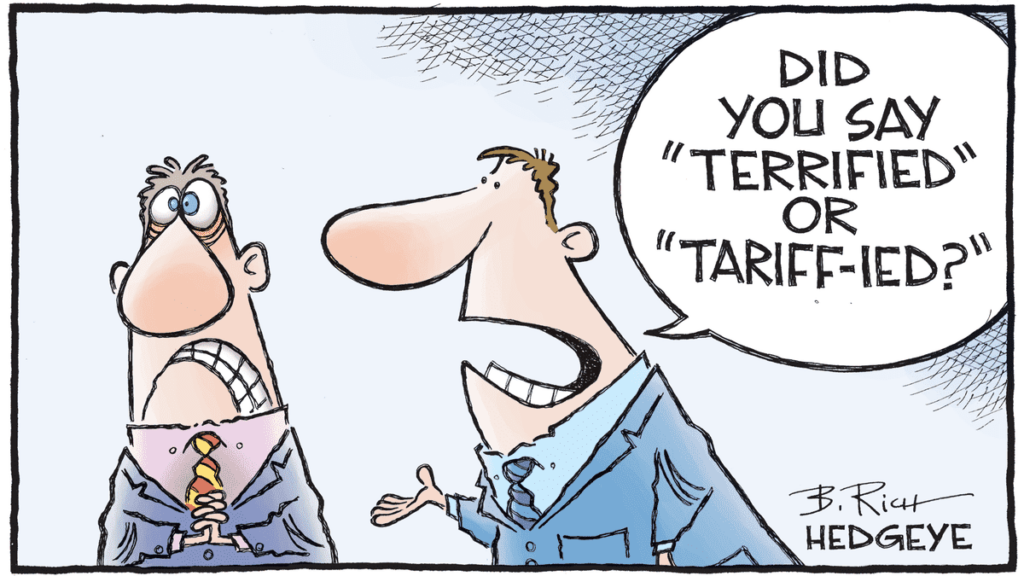
Let’s not lie to ourselves—we can tell ourselves whatever we want about yesterday’s session, but fundamentally, we were just filling the time with deep reflections on the state of the economy, just to keep our minds occupied until the announcement of the tariff rates, which will take place at 4:00 PM New York time this evening. In the meantime, we tried to get through Tuesday pretending to be interested in other things, knowing full well that we wouldn’t learn anything new about customs duties. The result was quite interesting: Europe was rising because the economy was slightly improving and the numbers were “less bad,” while the U.S. markets were rising simply because something had to happen.
A Macro Day to Keep Up Appearances
So, we spent a session trying to keep up appearances while waiting to learn more. To be honest, if you focus on everything that happened yesterday, there was a mountain of macroeconomic data that gave us a real opportunity to reflect on the current global economic situation. But we also had to ask ourselves whether it was really worth discussing, since we all know that, depending on what Trump says later today, anything could happen.
Well, “anything could happen” is a bit of an overstatement, since, according to “options experts,” the bets placed for tonight expect a movement of about ±2% on U.S. indices. Honestly, after 10 days of excitement for a 2% move, I wonder if I should have just gone back on vacation.
In any case, yesterday’s session was “pretty good” in Europe. A bit more hesitant in the U.S., but we still ended up in the green—except for the Dow Jones. But the Dow Jones had an excuse because Johnson & Johnson got hammered again by a judge over its talc cancer lawsuit. The judge rejected yet another financial settlement proposal from the American company.
This was the third time Johnson & Johnson tried to use one of its subsidiaries to take all the liability and use bankruptcy proceedings to pay out around $9 billion to victims. Apparently, the court found procedural flaws in the case, and Johnson & Johnson lost 7.5% during the session. The company also announced that it was withdrawing its proposals and the $9 billion settlement fund, opting instead to fight in court. In other words, the victims are nowhere near seeing a dime.
So, the Dow Jones was down. And initially, I wanted to talk about macroeconomics.
So, the Macro…
Yesterday in Europe, the DAX gained 1.7%, France rose by 1.10% but remained far from the 8,000-point mark. Meanwhile, Switzerland had a 0.7% increase, but the 13,000-point target still seemed out of reach.
But the main topic of the session—used to mask the waiting game—was economic reports. The CPI was released in Europe, coming in at 2.2%, exactly in line with expectations and 0.1% LOWER than last month. This suggested that “life is getting cheaper and that the European Union is managing things brilliantly.”
Of course, we prefer not to mention how much prices have risen over the past five years—because then the 0.1% variation would make you roll on the floor laughing! But in the meantime, it gave politicians an opportunity to show how great their work is and to imagine that, under these conditions, Madame Lagarde would have no choice but to continue easing monetary policy to please her dear investor subjects.
Following these figures, which once again prove that inflation is perfectly under control in the eurozone, thanks to our oh-so-competent leaders…
Let me pause here—does my sarcasm come across clearly? No, seriously, I AM BEING SARCASTIC. The number is better than last month, but given the overall state of the economy, there’s really nothing to brag about. But hey, we needed something to keep us busy while waiting for tonight.
Alright, back to where I left off: “thanks to our oh-so-competent leaders”…
So, following these figures that once again prove that inflation is perfectly under control in the eurozone, thanks to our oh-so-competent leaders, we also got the Manufacturing PMI numbers from Germany and France. In France, the number came in at 48.5—well below expectations since finance experts were hoping for 48.9. However, it was still considered GOOD because it was “less bad” than the previous month, which stood at 45.8.
Same story in Germany: the figure came in at 48.3—0.1 below expectations but “less bad” than last month’s 46.5. Considering the amount of money that has been injected into the defense sector over the past three weeks, this “less bad” outcome was the least we could expect.
That said, every time I hear economic figures being described as “good” because they are “less bad,” I can’t help but think that maybe we should just shut up and talk about something else. I don’t know… maybe tariffs?
Anyway, Europeans gained yesterday because things were “less bad”—all while waiting to find out how much they’ll have to pay to export Dacias to the U.S.

The Macro from Over There
Across the Atlantic, the market wasn’t exactly in great shape, but in the end, the Nasdaq and S&P 500 still managed to close higher, putting an end to a losing streak of a few days. There was a lot of focus on tariffs, but since we don’t know much beyond the announcement time, the market had to shift its attention elsewhere. Yesterday, that meant looking at the JOLTS report and the ISM Manufacturing PMI.
The JOLTS number came in weaker than expected at 7.568 million, and it was also lower than last month’s figure. However, the wonderful world of finance didn’t seem too bothered, still wanting to believe that the U.S. job market is doing just fine. So, in the end, JOLTS had no real impact on the market.
Then came the ISM Manufacturing PMI, which printed at 49. Expectations were at 49.5, and last month’s figure was 50.3. This means the U.S. economy is, once again, contracting based on this data. So, if we focus solely on yesterday’s session and these economic figures, we can quickly conclude that the economy isn’t heading in the right direction. Treasury yields for the 10-year and 2-year bonds took a hit, and talk of stagflation and/or recession has resurfaced. The Atlanta Fed, with its real-time GDP model, continues to warn that a recession is looming. And with the supposed introduction of 20% tariffs on imports starting tonight—potentially taking effect as early as tomorrow—inflation is likely to rise, economic growth will slow, and the Fed will be forced to take action. The only problem? No matter what Powell does—raise rates, cut rates, do nothing, or even start dancing a jig—he will always be blamed for everything.
In the End, Markets Go Up
But never mind economic data, as long as we get the market high. Yesterday, U.S. markets closed higher, defying all economic logic—though to be fair, economic logic isn’t exactly our strong suit these days. Anyway, with a decision like tonight’s on the horizon, global markets could have finished sideways instead of up or down, and I wouldn’t have been surprised.
This morning, Asia is doing absolutely nothing. No one really knows why. The three major indices are eerily quiet, and everyone is just waiting. The real question is: What exactly are we waiting for?
Right now, oil is trading at $71.24, gold is at $3,153, and Bitcoin is hovering around $84,000. Meanwhile, MicroStrategy just received its first negative coverage. The analyst in question, Gus Gala, works at a firm you’ve probably never heard of and believes that MicroStrategy’s approach of selling debt to buy Bitcoin is getting too expensive and will end badly. He slapped a SELL rating on the stock with a target price of $220, implying a 26% drop. To celebrate, MicroStrategy (or just “Strategy,” as it’s now called) surged 6% last night.
News? What News?
If you’re looking for today’s headlines, don’t expect much. About 80% of the news cycle is focused on tonight’s tariff announcements. And honestly, everything that could be said about it has already been said. We’ll revisit the topic tomorrow.
However, here are a few tidbits I picked up in my morning reads:
Newsmax, the IPO from Monday that skyrocketed 700% on its first day of trading, gained another 180% last night. It closed at $233 but then dropped 20% after hours. It seems to be Wall Street’s new meme stock, and while there are no options available, the limited float probably explains the current madness.
The number of car repossessions due to unpaid leases in the U.S. is at its highest level since the Subprime Crisis. A time that those under 20 might have heard of… but probably don’t remember.
The uncertainty index is at its highest level since we started calculating it.
The Atlanta Fed just revised its Q1 2025 GDP estimate downward again, now projecting -3.7%. When factoring in gold imports and exports, it now expects a -1.4% contraction for Q1 2025. Just two months ago, they were forecasting +3.8% growth for the same period. As they used to say: If it looks like a recession, sounds like a recession, and feels like a recession… I wonder what it could be!
Today’s Numbers & Tariff Decision
As for today’s much-anticipated events, we’ll have ADP employment data—a preview of what to expect on Friday. And then, FINALLY, we’ll be free from this suspense, as the tariff decision will be announced. Even if the outcome is bad, at least we’ll know… and we can start waiting for Trump’s next brilliant idea.
Futures are down 0.16%, and we’ll have to wait until 4:00 PM New York time to find out how exactly the White House plans to crush us.
May the FORCE be with you, enjoy your coffee, your pain au chocolat, your bircher, and have a great day! See you tomorrow for the debrief!

